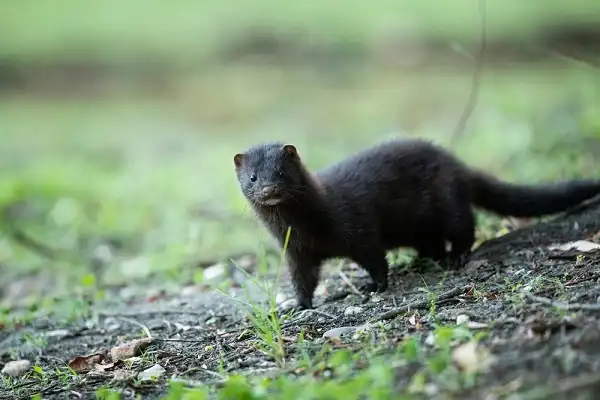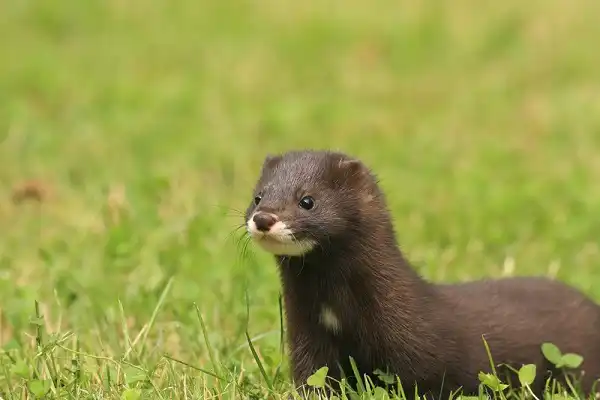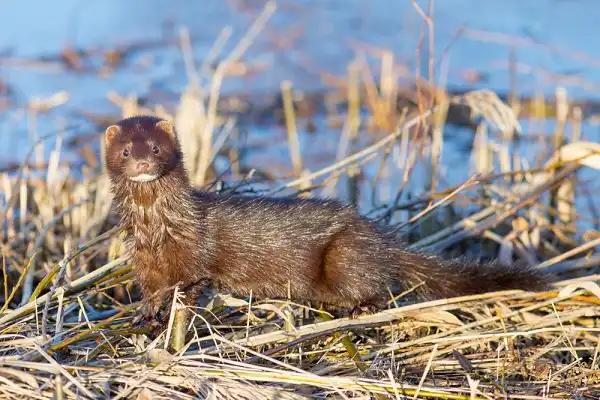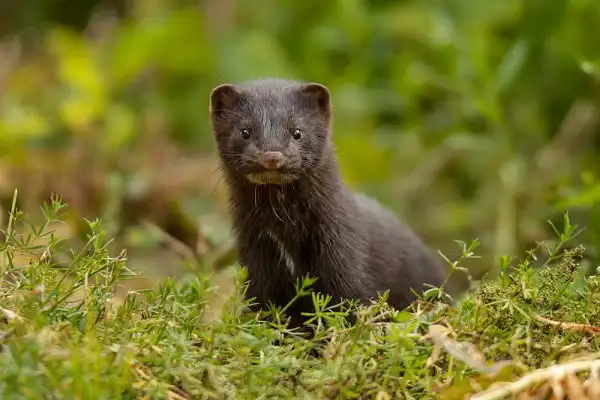Have you ever seen the gorgeous mink in its natural habitat? From their sleek, luxuriant fur to their mischievous personalities, minks are fascinating creatures with a rich history. Learn all about these captivating mammals here – we’ll take an in-depth look at where they live, how they interact and communicate with one another, their role in nature’s balance, and of course some fun facts! With a better understanding of mink ecology, it will be easier for us to appreciate the beauty that surrounds us every day. Let’s explore the world of minklets together!

Mink Description
Minks are a species of mustelids, native to many regions around the world such as North America, Europe, and Asia. These semi-aquatic mammals have long, slender bodies with short legs and a thick fur coat that comes in a variety of shades ranging from dark brown to black. Their fur is exceptionally soft and has been highly prized for centuries due to its warmth and silky texture. Minks also possess an array of facial markings that add to their striking appearance; these include white neck patches, eye rings, nose spots, and whisker marks.
Mink Habitat
Minks are typically found in wooded areas near water sources such as streams, rivers, ponds, and wetlands. They prefer to live in thick vegetation with plenty of hiding places; such as hollow logs and tree roots. They also like to build their dens under rocks or in the base of trees. Mink have been known to inhabit both saltwater and freshwater habitats, however, they usually remain within a few miles of their chosen home. Mink are fairly solitary animals that only form temporary social groups during the mating season; which begins around February and ends in May. During this time males will compete for a female’s attention by wrestling each other underwater while releasing bursts of pungent odors. After mating has occurred the female will find a suitable den to give birth at and construct a nest made from grasses and leaves.
Mink Diet
Minks are opportunistic eaters that have a varied diet consisting of fish, amphibians, small mammals, eggs, invertebrates, and even berries and fruits. They are usually active during the night when they hunt in shallow water by paddling around with their webbed feet to search for food. Minks have a keen sense of smell which helps them locate prey underwater or on land. They also use their sharp claws to dig up insects from the ground as well as climb trees in order to feed on birds and other animals. In addition to eating aquatic species such as trout, crayfish, or frogs, minks also feed on small mammals like mice and voles. They will often scavenge for carrion if available and supplement their diet with plants such as berries and fruits. In some areas of the world, they’ve been known to feed on salmon eggs in rivers during the spawning season, causing serious damage to local populations of fish.

Mink Size
Minks are small to medium-sized mammals, typically measuring between 25 to 40 centimeters in body length. They have short legs with webbed feet and weigh anywhere from 500 grams to 1.2 kilograms. Their slender bodies are covered in a thick coat of fur that is usually dark brown or black in color, with white patches on the neck and around the eyes. Minks also possess sharp claws that help them climb trees and dig burrows for shelter. Their powerful jaws and long canines provide them with the capacity to consume larger prey such as rodents or fish. In addition, their keen sense of smell helps them sniff out food sources both underwater and on land. Despite their relatively small size, minks are surprisingly agile creatures that are capable of leaping considerable distances when hunting or escaping predators.
Mink Lifespan
Minks have an average lifespan of around 4 to 5 years. However, some individuals have been known to live up to 8-10 years in the wild. In captivity, minks typically live longer due to the availability of food and the absence of predators. Mink reach sexual maturity at around 10 months old and usually reproduce once a year during the spring season, with litters ranging from 3-6 kits. The mother mink will often construct a nest out of dried grasses and leaves for her young before they are born. Minks have fairly high mortality rates due to predation by other animals such as owls, coyotes, or foxes, as well as humans who hunt them for their fur. They also face various environmental threats such as habitat destruction, pollution, disease, or parasites which can all reduce their lifespan significantly.
Mink Behavior
Minks are solitary animals and typically do not form social groups, except during the breeding season from February to May. During this time males will compete for a female’s attention by wrestling each other underwater while releasing bursts of pungent odors. After mating has occurred the female will find a suitable den to give birth at and construct a nest made from grasses and leaves. Minks have an impressive array of adaptive features which enable them to survive in many different environments around the world. They use their sharp claws to climb trees, dig burrows for shelter, and can even leap considerable distances when hunting or escaping predators. In addition, their keen sense of smell helps them sniff out food sources both underwater and on land; while their webbed feet allow them to paddle quickly across rivers and streams with ease.

Mink Speed
Minks are surprisingly swift and agile animals, capable of reaching speeds of up to 25 miles per hour. This is especially impressive considering their relatively small size. In addition to running on land, minks are also capable swimmers and can paddle quickly across rivers and streams with ease thanks to their webbed feet. When hunting prey or escaping predators, mink have been observed leaping considerable distances. They use both the strength of their limbs as well as the momentum created by their incredible speed to launch themselves forward up to 5 meters at a time!
Mink Hunting
Minks are skilled hunters that use their agility, sharp claws, and powerful jaws to capture prey. In order to hunt successfully, minks rely on a combination of both sight and smell. They are able to detect potential prey from up to 15 meters away using their keen sense of smell as well as their highly evolved vision. When hunting, mink are remarkably efficient predators that can take down larger animals such as rabbits or small rodents with ease. They have keen eyesight and sharp hearing which allows them to locate their prey even in the dark or dense vegetation if necessary.
Minks have also been known to ambush unsuspecting aquatic prey such as trout or crayfish by swimming stealthily underneath them. With the help of their webbed feet, they can paddle quickly across rivers and streams in pursuit of their quarry before unleashing a powerful bite with their long canines. In addition to hunting on land, minks will often venture into ponds and other freshwater bodies in search of food. They possess incredibly strong claws that allow them to dig through mud and silt in search of aquatic species such as frogs, crustaceans, or fish. Their powerful jaws also provide them with the capacity to consume larger prey such as rodents or birds on land.
Mink Diseases
Minks can suffer from a variety of diseases and parasites that can reduce their lifespan significantly. The most common diseases that affect minks are bacterial infections, viral infections, fungal infections, and parasitic infections caused by worms or mites. Bacterial infections in minks can be caused by a variety of different bacteria including Salmonella, E. coli, and Pasteurella multocida. These bacteria can cause severe respiratory problems such as pneumonia and bronchitis in affected animals which can result in death without proper treatment. Viral infections are also a major concern for minks and diseases such as Aleutian disease virus (ADV) and rabies can cause paralysis or even death if left untreated.
In addition, viral infection may be transmitted to other animals through direct contact or via contaminated water sources. Fungal infections such as ringworm, cryptococcosis, or candidiasis can also affect minks and often result in skin lesions that can spread to other parts of the body if not treated immediately. Parasitic infestations caused by worms or mites are another issue faced by these animals and can lead to anemia, malnutrition, weight loss, diarrhea, and vomiting if left unchecked. Furthermore, some parasites have been known to transmit deadly diseases between species such as rabies or canine distemper virus which can be fatal to both humans and animals alike.

Mink Predators
Minks may be small and agile creatures, but they still have to contend with a variety of predators in the wild. Some of the most common predators that pose a threat to mink include foxes, coyotes, wolves, birds of prey such as hawks and owls, weasels, minks, otters, and humans. Foxes are one of the biggest threats to minks due to their larger size and strength. Coyotes are also known to hunt mink when other prey is scarce. Wolves will occasionally hunt mink but usually prefer larger animals such as deer or elk. Birds of prey such as hawks or owls will swoop down from the sky and snatch up unsuspecting minks for their next meal.
Conclusion
Minks are truly remarkable creatures with impressive adaptive features that enable them to survive in a wide variety of habitats around the world. From leaping over obstacles while chasing down mice on land to paddling quickly across rivers in search of food; these resilient animals demonstrate just how adaptive nature can be! In addition, minks can suffer from a variety of diseases and parasites which can reduce their lifespan significantly if not properly treated. It is therefore important for mink owners to take preventive measures against illnesses such as providing adequate housing conditions and keeping their environment clean at all times so that these incredible creatures remain healthy!
Frequently Asked Question


